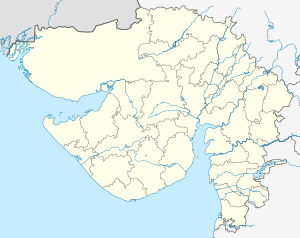Sardar Khan's Roza
| Sardar Khan's Mosque and Tomb | |
|---|---|
 Nawab Sardar Khan's Roza c.1860 | |
| Religion | |
| Affiliation | Islam |
| Status | Active |
| Location | |
| Location | Jamalpur, Ahmedabad |
| Municipality | Ahmedabad Municipal Corporation |
| State | Gujarat |
| Geographic coordinates | 23°00′56″N 72°35′02″E / 23.015561°N 72.583761°E |
| Architecture | |
| Type | Mosque and tomb |
| Style | Indo-Islamic architecture with Persian domes |
| Completed | 1685 |
| Specifications | |
| Dome(s) | 3+6 |
| Minaret(s) | 2 |
Sardar Khan's Roza or Nawab Sardar Khan's Mosque and Tomb, is a mosque and tomb complex in Jamalpur area of Ahmedabad, India.
History and architecture[edit]
Sardar Khan was a minister of Ahmedabad during Mughal rule. He did not provide help to Mughal prince Dara Shikoh, who fled from captivity of Aurangzeb.[1]
Sardar Khan's Roza was built in 1685. The tomb of Sardar Khan was built of stone and had a marble floor. The mosque was made of bricks situated on high platform, and the façade of the mosque had three pointed arches and two minarets on either side. The minarets were four storeys high, which were octagonal at the base and circular in the upper parts. This minaret had gilt balls on the top and had three large onion shaped domes, while the gateway had two domes too.[2][3][4] The tomb and mosque have been encroached since 1884 and are in bad shape now.[1][5][6][7]
References[edit]
- ^ a b India Today. Vol. 17. Living Media India Pvt. Limited. 1992. p. 113.
- ^ Gazetteer of the Bombay Presidency: Ahmedabad. Government Central Press. 1879. p. 319.
dastur khan mosque.
 This article incorporates text from this source, which is in the public domain.
This article incorporates text from this source, which is in the public domain.
- ^ "Nawab Sardar Khan's Mosque, on the Jamalpur road, Ahmadabad". British Library. Retrieved 21 December 2014.
- ^ Desai, Hemang (26 November 2010). "The story of how architecture in Gujarat got a Mughal touch…". DNA. Retrieved 21 December 2014.
- ^ John, Paul (29 July 2012). "Mughal icons decaying in citye". The Times of India. Retrieved 21 December 2014.
- ^ "PEARLS OF PAST: Need Some Elbow Room". The Times of India. 25 November 2011. Archived from the original on 13 December 2014. Retrieved 7 December 2014.
- ^ Jani, Mehul (22 November 2011). "Neglect buries two heritage tombs". Times of India. Retrieved 8 December 2014.[dead link]


